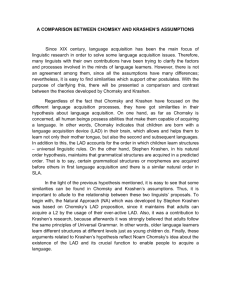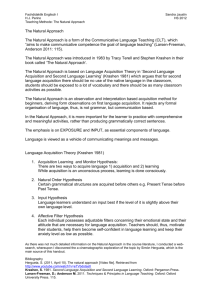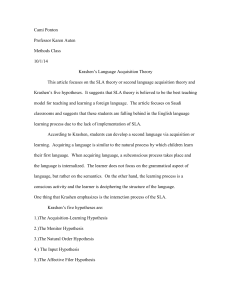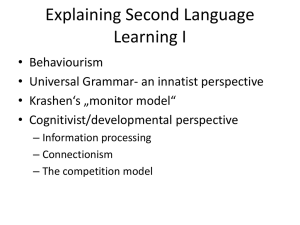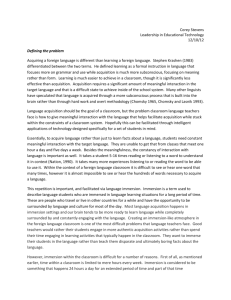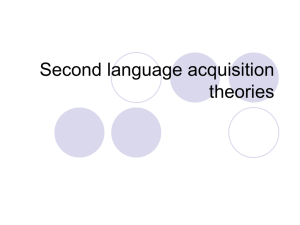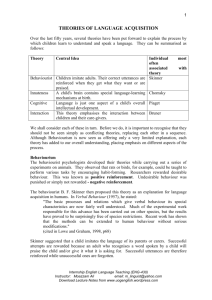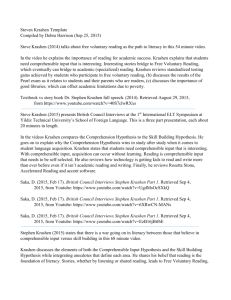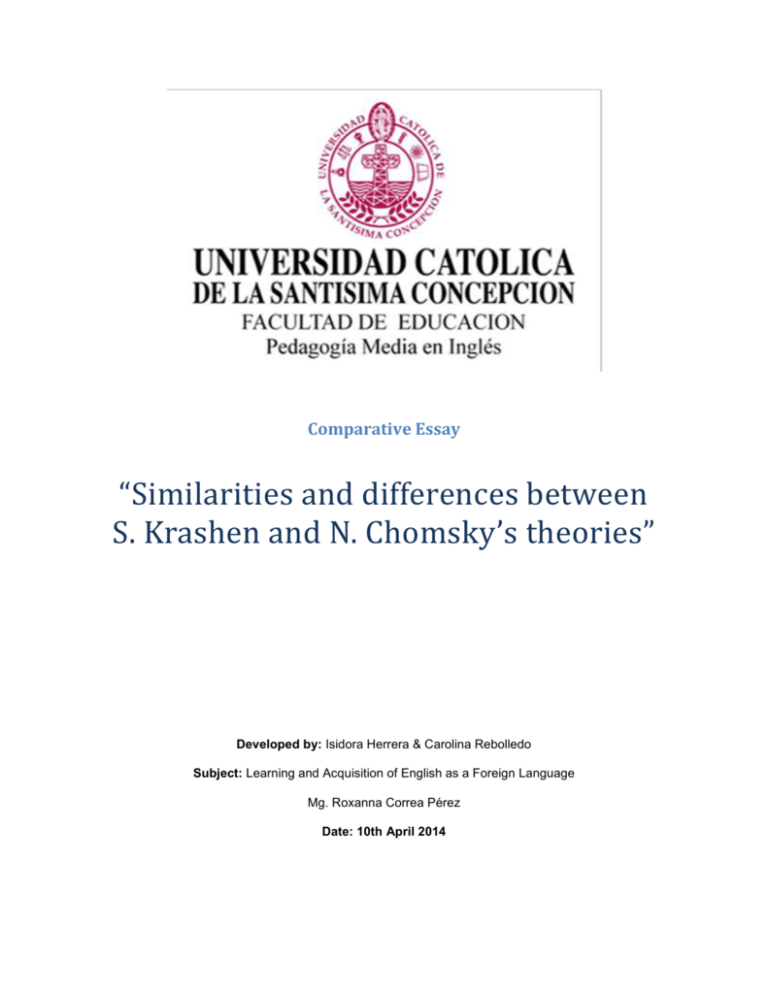
Comparative Essay
“Similarities and differences between
S. Krashen and N. Chomsky’s theories”
Developed by: Isidora Herrera & Carolina Rebolledo
Subject: Learning and Acquisition of English as a Foreign Language
Mg. Roxanna Correa Pérez
Date: 10th April 2014
Communication is an elemental human behavior which consists basically on producing
systematic verbal utterances to convey meaning. This is indeed related to language
learning and acquisition, topics in which many theories and approaches are found as the
best way to understand and explain the process of communication in human beings.
During childhood, people begin the task of the acquisition of a language. In the human
behavior, cognitive maturity or metalinguistic awareness are involved as soon as human
beings start to communicate themselves. Two big theories developed by Stephen Krashen
and Noam Chomsky will cover this comparative essay, in order to see some differences
and similarities between these points of view of the language development and how it
works according to them.
One of the differences found between Krashen’s “Five Hypothesis Theory” and Chomsky’s
“Universal Grammar” theory is how the processes of the acquisition of a language are
defined. According to Brown (2007), Krashen defines ‘learning’ as a conscious process
and acquisition as a ‘subconscious’ and ‘intuitive’ one. On the other hand, as cited in Cook
(2010), “Universal Grammar model claims that these principles and parameters are built
into the human mind”. This means that Chomsky’s Universal Grammar (UG) explains how
language is built and stored in the human brain and does not consider language and
acquisition as a process to be followed. Hence, language is already stored in mind as a
device called LAD (Language Acquisition Device).
Another difference between Krashen and Chomsky’s theory is that Krashen proposed the
Affective Filter Hypothesis. This hypothesis, as it is explained in Lightbown, Spada (2011)
refers to feelings, motives, needs, and emotional states that people have at the moment to
acquire a language. In certain moments do not permit students to continue acquiring a
language, even if there is the appropriated input. However, Chomsky’s theory may not
explain and specify the affective aspects of acquiring a new language in the article studied
previously. Authors such as Robert Bley-Vroman (1983) and Jacqueline Schachter (1990)
mentioned in Lighbown, Spada’s article (2011) argue that second language acquisition has
to be explained by some other theory that would consider the psychological aspects of
learning, because Chomsky’s theory of acquisition of a second language is not
appropriated for students who have passed the critical period.
A similarity, but also a difference between Krashen and Chomsky is the concept and the
use of input. This concept is explained in both theories, but the importance given might
differ. On one hand, Krashen’s input hypothesis, as it is explained in Lightbown, Spada
(2011) is a process in which acquisition occurs when individuals are exposed to a
language. It is represented by the formula “i + 1”. The “I” represents the level that a person
has already acquired and “+ 1” means that the content could go even beyond that level. In
other words, Krashen’s five hypothesis theory is mostly based on input. Nevertheless,
Chomsky might not base his theory on input and it is seen as a secondary element.
Universal grammar follows primarily the sequences patterns order and not context, as it is
said before throughout this essay.
As a conclusion, the differences and similarities seen on this essay between Krashen and
Chomsky can be summed up as the discrepancy on the process of how language can be
acquired, and also how context is more relevant on Krashen’s theory. On the contrary,
Chomsky’s theory might not consider context relevant in order to acquire the language. A
similarity has also been set during his essay. Both theories use the same concept to
explain what language needs to concrete the act of communication. However, theories
differ in the definition and perception of input. For instance, in the “Five Hypothesis
Theory”, the main concept helped to understand the authors’ main point compared to
“Universal Grammar” theory, in which the input concept might not be relevant in the same
way.
REFERENCES
Brown,H.D. (2007). “Principles of Language Learning and Teaching.” In Pearson
Longman (Ed). United States: San Francisco State University. p. 294-299.
M, Lightbown. N, Spada (2011). “How languages are learned”. In Oxford University
Press (Ed). New York. p.30 -49.
Cook, V (2010). “The relationship between first and second language learning
revisited.” In E. Macaro (ed). The Continuum Companion to Second Language
Acquisition, Continuum, p.137-157, 2010 web-version.

